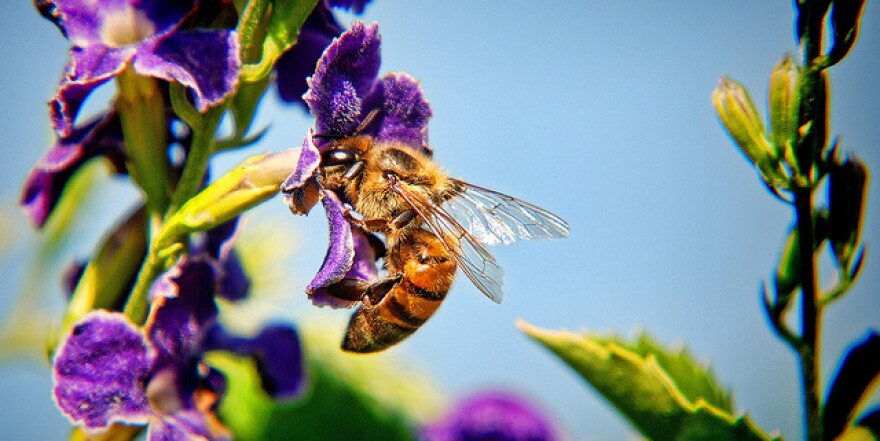Truth matters. Community matters. Your support makes both possible. LAist is one of the few places where news remains independent and free from political and corporate influence. Stand up for truth and for LAist. Make your year-end tax-deductible gift now.
Why California native bees are struggling to keep up with honey bees

The next time you come across a big bumble bee you might want to give them space to do their pollinating thing.
Turns out they’ve got a tough time of it already, thanks to the non-native western honey bee, which a new study shows can vastly outnumber native bees.
In a study published this week, James Hung, an assistant professor at the University of Oklahoma, and his colleagues found that populations of western honey bees at their study sites in San Diego County made up 98% of bee biomass, or an estimated 90% of individual bees.
“For honey bees to be almost the entirety of all the bee biomass out there, that is shocking, especially for a species that is not native to an ecosystem,” Hung said.
While honey bees are extremely important for agricultural activity — like growing food — they’re also pollen hogs. According to Hung’s study, “honey bee foragers remove 80% of total pollen during the first day flowers open on three common native [plant] species.”
That means honey bees don’t leave a lot for native pollinators to sustain their own populations, Hung said.
The way in which honey bees pollinate can also create problems for native plant ecosystems. That’s because honey bees often move pollen from one flower to another on the same plant, sometimes leading to inbreeding. And inbred plant offspring often are less fit than those that come from different plants from the same species.
What can be done?
Hung said there’s no quick and easy solution to give California native bees a leg up.
“It’s not like we can just declare the honey bee persona non grata as a harmful invasive species and just start wiping them out,” Hung said.
Instead, Hung said, there needs to be ongoing conversations between farmers, beekeepers, conservation biologists and habitat managers on the predicament of native bees.
“To rethink how we put out zoning laws, how we put out regulations, to make sure that beekeepers, when they are transporting large numbers of honey bee colonies throughout the American landscape, that they are following routes where their honey bees will not have such a large impact on sensitive ecosystems,” Hung said.
So if you’re lucky enough to come across a California native valley carpenter bee — commonly known as the "teddy bear" bee because of its fluffy, yellow hair — remember, they're the underdog. And whatever you do, don’t swat it.








